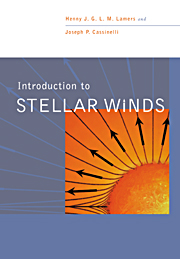Book contents
- Frontmatter
- Contents
- Preface
- 1 Historical overview
- 2 Observations of stellar winds
- 3 Basic concepts: isothermal winds
- 4 Basic concepts: non-isothermal winds
- 5 Coronal winds
- 6 Sound wave driven winds
- 7 Dust driven winds
- 8 Line driven winds
- 9 Magnetic rotator theory
- 10 Alfvén wave driven winds
- 11 Outflowing disks from rotating stars
- 12 Winds colliding with the interstellar medium
- 13 The effects of mass loss on stellar evolution
- 14 Problems
- APPENDIX 1 The chronology of stellar wind studies
- APPENDIX 2 Elements of thermodynamics
- APPENDIX 3 De l'Hopital's rule for equations with a singular point
- APPENDIX 4 Physical and astronomical constants
- Bibliography
- Object index
- Index
11 - Outflowing disks from rotating stars
Published online by Cambridge University Press: 05 June 2012
- Frontmatter
- Contents
- Preface
- 1 Historical overview
- 2 Observations of stellar winds
- 3 Basic concepts: isothermal winds
- 4 Basic concepts: non-isothermal winds
- 5 Coronal winds
- 6 Sound wave driven winds
- 7 Dust driven winds
- 8 Line driven winds
- 9 Magnetic rotator theory
- 10 Alfvén wave driven winds
- 11 Outflowing disks from rotating stars
- 12 Winds colliding with the interstellar medium
- 13 The effects of mass loss on stellar evolution
- 14 Problems
- APPENDIX 1 The chronology of stellar wind studies
- APPENDIX 2 Elements of thermodynamics
- APPENDIX 3 De l'Hopital's rule for equations with a singular point
- APPENDIX 4 Physical and astronomical constants
- Bibliography
- Object index
- Index
Summary
Early-type stars often show rotationally broadened photospheric lines that indicate that they are rotating with equatorial speeds in the range 100 to 400 km s-1. These stars have radiatively driven winds owing to the strong line opacities in their outer atmospheres, as described in Chapter 8. The rotation of the stars leads to interesting effects, the most prominent of which is the tendency to concentrate the outflowing material toward regions near the equatorial plane. The equatorial material is moving outwards from a star whose surface is rotating at a speed below the critical speed. Therefore these disks are called outflowing disks or de-cretion disks, in contrast to the ‘accretion disks’ around pre-main sequence stars or around the gaining stars in binary systems with mass transfer.
In this chapter we consider only the formation of outflowing disks. For a star that has a stellar wind and also an outflowing disk, the contrast in density from equator to pole is typically about a factor of ten or so. We discuss two basic pictures for producing such a contrast. The first is a piece-wise spherical outflow in which the equatorial density is enhanced because the mass flux from the near-equatorial latitudes is larger or the wind velocity is lower than those in the polar regions. Such a wind could be the result of the ‘rotation induced bi-stability’ (RIB) model of Lamers and Pauldrach (1991). The second is the wind compression picture in which the streamlines of the gas from both hemispheres of a rotating line driven wind are bent towards the equatorial plane.
Information
- Type
- Chapter
- Information
- Introduction to Stellar Winds , pp. 319 - 354Publisher: Cambridge University PressPrint publication year: 1999
